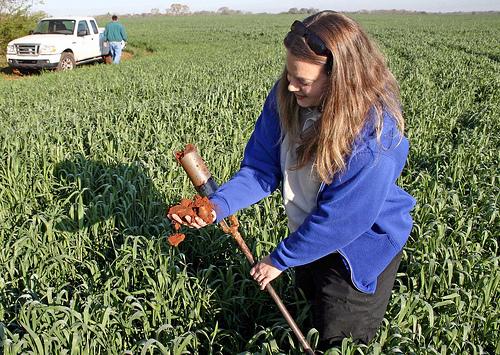Soil testing may identify a lack of plant nutrients critical for optimum growth. For instance, nitrogen, phosphorus, or potassium levels may be limiting plant growth, along with a lack of other plant macronutrients (calcium, magnesium, and sulfur) and micronutrients (chloride, iron, boron, manganese, zinc, copper, molybdenum, and nickel).
Soil tests can also determine organic matter, pH, soluble salts, available nutrients, element toxicities, soil texture, and numerous other properties.
Soil testing may also identify limiting factors on a site such as a pH outside the desirable range for the plants (low pH or high pH), low organic matter, excess levels of particular elements, or high salinity (concentration of salts).
When and How to Test Soil
Soils can be tested in the spring or fall. Spring sampling may be desirable to determine plant needs before the growing season starts. Fall sampling may be preferred if you want to fertilize later in the year.
Plan ahead by contacting the laboratory that will analyze the soil to find out how much time it will take to receive the results, and allow time for implementation of fertilizer recommendations and corrective measures.
- Use some kind of auger-like device or soil probe/tube
- Scrape away surface litter
- Sample the soil from the surface down to 12 inches (turf areas can be sampled from 0 inches to 6 inches)
- Be sure the sample is representative – in other words, obtain equal amounts of soil from each sampling increment. An easy way to do this is to
- Multiple soil samples should be collected from any one given area
- Composite into one sample to minimize the cost of analysis
When compositing multiple samples into one sample, thoroughly homogenize the soil, then take a subsample (approximately two cups) to submit to a laboratory for analysis. County Cooperative Extension Agents can help locate labs that can analyze the samples if needed. Note: if testing for nitrate-nitrogen, sample from the 12 inch to 24 inch depth as well, and sample any problem areas separately. Be sure to immediately air-dry any soils that will be submitted for nitrogen analysis.
Laboratories and County Extension Agents can provide recommendations for soil treatments based on the results of the analyses. A brief history of plants/crops grown to date and any soil treatments used in the past can be helpful. Detailed information on interpreting soil analyses is available – see Understanding Your Soil Test
Keep accurate records of fertilizer applications and other soil treatments along with associated plant growth and quality. This will enable correlation of yield and plant performance to soil test results.

Additional Resources:
Northwest
Montana: Soil Sampling Strategies
Southeast
Arkansas: Understanding the Numbers on Your Soil Test Report
